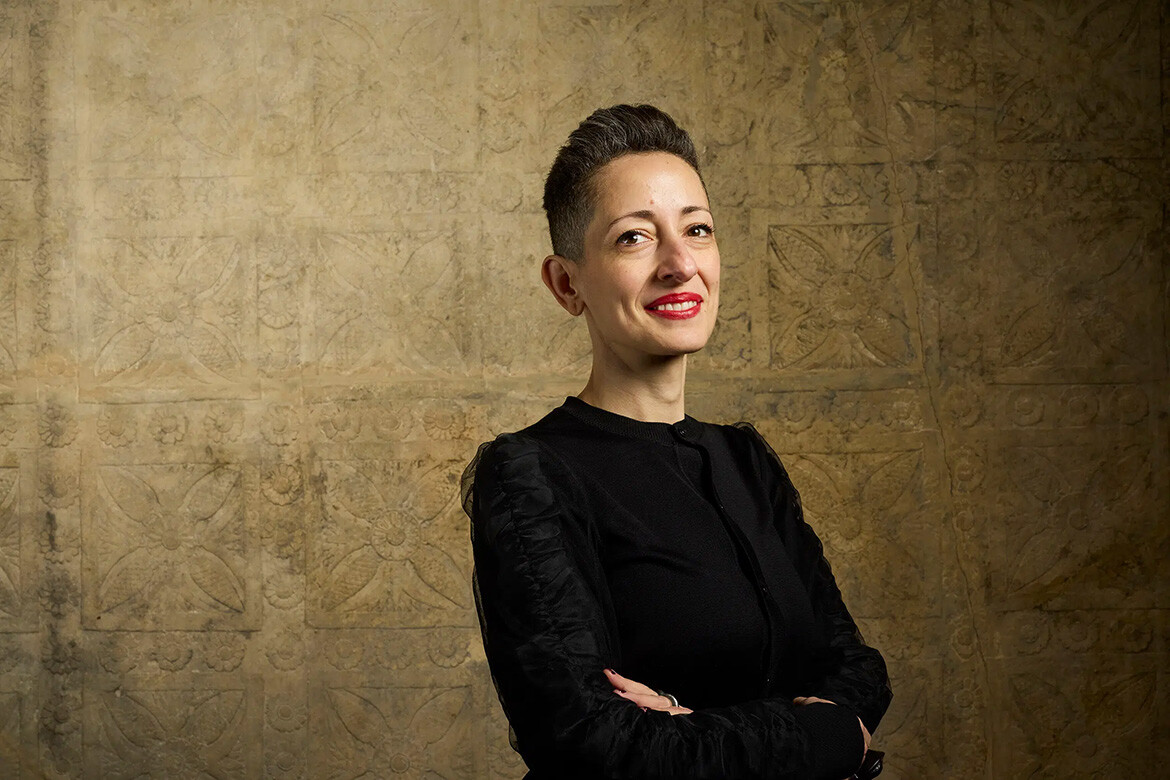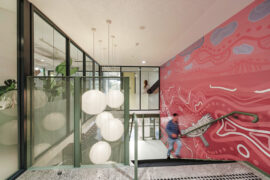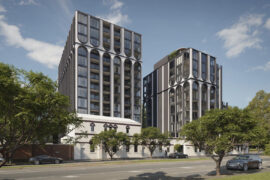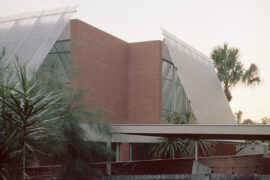As French-Lebanese Architect Lina Ghotmeh prepares for lectures in Melbourne and Sydney, we hear about the philosophy shaping her internationally celebrated practice.

Photo by David Levene.
August 26th, 2025
French-Lebanese architect Lina Ghotmeh has made her mark with projects that span continents and cultures, including the Estonian National Museum, Beirut’s Stone Garden tower, the Ateliers Hermès — the first passive, energy-positive and low-carbon industrial building in France — and the redesign of the Western Range galleries of the British Museum.
She describes her approach as an ‘Archaeology of the Future’, digging into the history, memory and craft of each place to create buildings that are both rooted in context and open to the future. In this conversation, Ghotmeh shares how her philosophy shapes work that is ecological, humane and always in dialogue with its surroundings.
Clémence Carayol: Your philosophy of ‘Archaeology of the Future’ has become a hallmark of your work. How do you ensure this approach remains relevant across such diverse cultural and geographical contexts?
Lina Ghotmeh: I always begin with a sense of questioning. For me, architecture is never about imposing a preconceived form but about listening — to the land, to the history, to the invisible layers that exist in each place. What I call ‘Archaeology of the Future’ is a way of excavating these layers: the physical, the cultural, the social, even the emotional.
Each site has its own strata, its own contradictions, and by weaving them into the design, architecture becomes deeply anchored in its context while simultaneously projecting forward. This is why the Estonian National Museum could not resemble Stone Garden in Beirut, and why the Serpentine Pavilion in London took yet another form. Each one arises from its own soil, but all are born of the same commitment to specificity and continuity.
As a French-Lebanese architect based in Paris, how has your personal history shaped the way you read and interpret the built landscape?
My upbringing in Beirut shaped me profoundly. In that city, you grow up among ruins, unfinished buildings and constant rebuilding — it is an environment where history is never distant but part of one’s everyday reality.
One cannot ignore memory; it is inscribed in walls, in scars, in the absence of things and in the voids left out by events. This taught me to think of architecture with humility. For me, to build is not simply to add something new, but it is also about revealing what is already there, to make visible what might otherwise remain hidden.
Living between Lebanon and France has also given me a double lens: one that is rooted in the Mediterranean, and another that engages the wider, more global discourse from Paris. This duality nourishes my practice.
The Stone Garden tower in Beirut is both a residential project and a deeply personal statement about the city. How did you balance aesthetic ambition with the weight of memory and history?
Stone Garden is a project very close to my heart, because it embodies both personal and collective memory. I wanted the building to echo the resilience of Beirut, to stand almost like an inhabited sculpture that carries traces of the city’s wounds without being defined by them. Its porous facade, made of hand-combed earth-based plaster, recalls bullet-scarred surfaces but transforms them into a new language of silence and reflection.
The interstitial gardens punctuate the building with life, offering residents spaces for breathing and regeneration. Importantly, the facade was realized through the hands of local craftsmen, which turned the act of building into a collective healing process. The result is a building that is not nostalgic but forward-looking — one that reminds us of fragility while celebrating continuity.
Craft and the hand-made play a central role in your designs. In an age of rapid technological development, how do you see traditional craftsmanship co-existing with digital fabrication?
Craft is essential in my practice. When I work with artisans — whether brick-makers in Normandy, plaster workers in Beirut or woodworkers in Japan — I am tapping into centuries of accumulated intelligence. These crafts can be considered ecological in the truest sense: they are born of place, of available resources and of human intimacy with materials.
Technology, of course, is a part of contemporary practice, and digital tools can expand possibilities, but they must not erase the trace of the hand. They are tools that can enhance life, architecture and allow us to push further what constitutes us as humans. I believe the future of architecture lies in this dialogue — between the precision of new technologies and the poetry of manual work. Craft gives architecture soul; it ensures that buildings are not only efficient, but also tactile, meaningful and loved.
Many of your projects, like the Ateliers Hermès, set benchmarks for low-carbon, energy-positive design. How do you reconcile ecological imperatives with the pressures of cost and speed in contemporary construction?
Ecology is not really optional — it is an ethical foundation. I see sustainability not simply in terms of regulations or energy numbers, but in terms of care: care for the environment, for people, for culture. At Hermès in Normandy, we used bricks made by hand from local clay, reducing carbon emissions while supporting regional knowledge and traditions.
The building is not only energy-positive but also deeply human. True sustainability must also generate beauty, because beauty ensures that a building will be cherished and maintained rather than discarded. Pressures of cost and speed are realities, but they cannot justify irresponsibility. Instead, they should push us to innovate, to find ways of building that are both resourceful and generous.
Having worked on institutional landmarks such as the Estonian National Museum and the British Museum galleries, how do you approach integrating contemporary architecture into highly charged historical sites?
These projects demand sensitivity to multiple layers of time. In Estonia, we extended the national museum from the scar of a former Soviet military airfield, transforming a site of occupation into a space of cultural pride. It was about addressing tumultuous memory through architecture.
At the British Museum, the challenge is different: it is about creating spaces that can hold a global collection, one that embodies both beauty and complexity, without neutralising the profound narratives it contains. For me, architecture in such contexts must act as a mediator — it should not dominate, but frame, allowing history, present, and future to converse within the same space.
Your practice often navigates between the intensely local and the globally visible. How do you decide which elements of a site’s heritage should be amplified for an international audience?
I never begin by thinking of a global audience. I begin with the site itself, its own people — with its stories, its traditions, its silences. What I try to amplify, and reveal is the essence that already exists, whether through materials, craftsmanship or memory. In doing so, I believe the local becomes universally resonant.
Architecture has the power to dignify what is fragile or overlooked and to bring it into dialogue with the world. By rooting projects deeply in their context, they paradoxically gain the ability to speak across cultures.
You have taught at Yale, Harvard, and the University of Toronto. How has teaching informed your own design thinking, and vice versa?
Teaching allows me to explore architecture as a field of ideas as much as a profession of building. For instance, in one of my studios at Harvard we investigated the relationship between imperfect stones and society’s perceptions of ageing — an exercise in connecting material imperfection with cultural values.
These discussions with students expand my practice and remind me that architecture is always about more than form; it is about meaning. At the same time, my practice brings urgency to my teaching. The challenges I face in the field — climate responsibility, social cohesion, craft — become the very questions I ask my students to confront.
The Serpentine Pavilion is known for sparking public debate around architecture. What conversations did you hope to ignite with your 2023 design?
With À Table, I wanted to create a space for conviviality and reflection. Inspired by the Mediterranean tradition of gathering around a table to share food, the pavilion invited people to sit together and engage in dialogue. In a time marked by division, it was a call to rethink our relationships — with each other, with the Earth, with what and how we eat.
Ecologically, the pavilion embodied the same ethos: it was built entirely of bio-sourced timber, light and demountable, designed to exist in symbiosis with its environment. My hope was to spark conversations about care, generosity and our shared responsibility toward the planet.
Looking to the future, what role do you think architecture must play in fostering not only sustainability but also cultural continuity in the face of global crises?
I believe architecture must act as a form of care and resistance. In the face of climate change, conflict and displacement, it cannot remain neutral. It must protect memory while offering new possibilities for life.
This means designing buildings that are ecological, yes, but also deeply human spaces that people love, that give them a sense of belonging and beauty. If a place is loved, it will be maintained and, through this continuity, both culture and nature are preserved. Architecture alone cannot solve global crises, but it can provide the spaces of gathering, resilience and imagination that are crucial to our collective future.
Lina Ghotmeh will speak at the University of Melbourne on 26th August and UTS on 28th August – tickets are available here and here.
INDESIGN is on instagram
Follow @indesignlive
A searchable and comprehensive guide for specifying leading products and their suppliers
Keep up to date with the latest and greatest from our industry BFF's!

For those who appreciate form as much as function, Gaggenau’s latest induction innovation delivers sculpted precision and effortless flexibility, disappearing seamlessly into the surface when not in use.

For a closer look behind the creative process, watch this video interview with Sebastian Nash, where he explores the making of King Living’s textile range – from fibre choices to design intent.

Sydney’s newest design concept store, HOW WE LIVE, explores the overlap between home and workplace – with a Surry Hills pop-up from Friday 28th November.

At the Munarra Centre for Regional Excellence on Yorta Yorta Country in Victoria, ARM Architecture and Milliken use PrintWorks™ technology to translate First Nations narratives into a layered, community-led floorscape.

From radical material reuse to office-to-school transformations, these five projects show how circular thinking is reshaping architecture, interiors and community spaces.

Designed by Woods Bagot, the new fit-out of a major resources company transforms 40,000-square-metres across 19 levels into interconnected villages that celebrate Western Australia’s diverse terrain.

In an industry where design intent is often diluted by value management and procurement pressures, Klaro Industrial Design positions manufacturing as a creative ally – allowing commercial interior designers to deliver unique pieces aligned to the project’s original vision.
The internet never sleeps! Here's the stuff you might have missed

At Melbourne Design Week, Plus Studio brought together planners, designers and local government voices to unpack the realities of urban densification.

With 26 shortlisted homes, a 13-member jury and four standout winners, the 2025 Habitus House of the Year program wrapped up last night in Sydney with Winnings.

At the Munarra Centre for Regional Excellence on Yorta Yorta Country in Victoria, ARM Architecture and Milliken use PrintWorks™ technology to translate First Nations narratives into a layered, community-led floorscape.